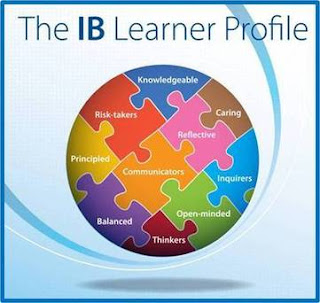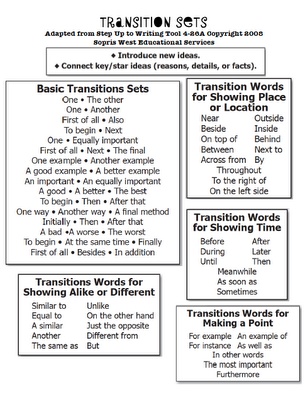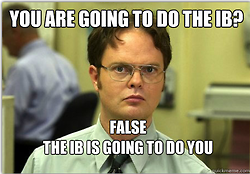Choose Good Words for Transitions
Friday, March 29, 2013
Outline Sample
OUTLINE GRAPHIC
ORGANIZER
Background/Set up/”Hook”
Thesis sentence
J.K. Rowling uses the character of Mrs.
Weasley as a symbol
of mothers for all the children in the book.
I.
There are no other motherly figures (STATEMENT)
A. Aunt
Petunia is not maternal to anyone, and no one else has a mother (EVIDENCE)
B. Hermione’s
mother is never seen, Neville’s mother is in a nut house, Luna’s mother is dead(EVIDENCE)
C. The
other women are in no way maternal (EVIDENCE)
i.
Professor McGonagle
ii.
Bellatrix LeStrange
D. This
sets Mrs. Weasley apart as the only motherly woman in the whole series of books
(ANALYSIS)
II.
Mrs. Weasley does motherly things (STATEMENT)
A. She
is a housewife, and has no job (EVIDENCE)
B. She
cooks and cleans (EVIDENCE)
C. She
knits sweaters (EVIDENCE)
D. All
these skills are ones that a perfect mother would have, and even though Mrs.
Weasley is not perfect, the author gives her all these skills that an ideal
mother would have and that makes her the symbol mother of them all (ANALYSIS)
III.
Ron, Hermione and Harry all live with her at some point
(STATEMENT)
A. Ron
lives there and is her son; has brothers that all live there as well (EVIDENCE)
B. Hermione
seems to be there every summer (EVIDENCE)
C. Harry
always says he feels at home there, and wants to leave his actual home to go
there (EVIDENCE
D. By
providing the home for all the children, Mrs. Weasley becomes the mother for
them all (ANALYSIS)
IV. Conclusion
Re-State the evidence;
re-word your thesis!
Reminders:
- Roman
numerals must be arranged so that the periods align.
- Each
letter in second-level division is capitalized and followed by a period.
- Arabic
numbers in third-level divisions are followed by a period.
- The
first word in headings and subheadings begin with uppercase letters and
other words (except proper nouns) begin with lowercase letters.
Wednesday, March 27, 2013
ABCs of IB (or ToK, I.A, IB, IOP, What?) aka the Alphabet Soup of IB
What do all these Acronyms MEAN?!?!?!
 T.o.K. stands for Theory of Knowledge. It is a class where you learn how you know what you know. And if you know it at all.
T.o.K. stands for Theory of Knowledge. It is a class where you learn how you know what you know. And if you know it at all.
C.A.S. stands for Creativity, Action and Service. These are projects that the 11th and 12th graders are involved in for credit.
I.A. stands for Internal Assessments. This is an assignment that is assessed by the teachers at our school. Some may be sent out as samples. Sometimes, these may have limited teacher input.
E.A. is an External Assessment. These are assignments that are graded by IB assessors.
I.B. is the International Baccalaureate. It is the programme of study.
I.O.P. Individual Oral Presentation. This can also be an I.A. or an E.A.
E.E. is the Extended Essay, a 4000 word paper on the topic of the student's choice.
S.L. is Standard Level.
H.L. is Higher Level.
P.P.A. is a Practical Play Analysis (did you think there was only acting the Theatre class?).
These are only the beginning. Want to see more? Check here and here. And this is kind of funny, here. Once you have read all these, you can quiz yourself here
Tuesday, March 26, 2013
Annotations (Poetry)
When annotating a poem (or any writing) record all your thoughts. Here is an example of the poem "Digging" annotated. Note that there is reference to tone, language, symbolism, and rhythm among other things. This will make writing an analysis a snap!
Command Terms in Science
IB Science Command Terms
What are they asking me to do?!?!?!?!
Define
Give the precise meaning of a word, phrase or physical quantity.
Draw
Represent by means of pencil lines.
Label
Add labels to a diagram.
List
Give a sequence of names or other brief answers with no explanation.
Measure
Find a value for a quantity.
State
Give a specific name, value or other brief answer without explanation or calculation.
Annotate
Add brief notes to a diagram or graph.
Apply
Use an idea, equation, principle, theory or law in a new situation.
Calculate
Find a numerical answer showing the relevant stages in the working (unless instructed not to do so).
Describe
Give a detailed account.
Distinguish
Give the differences between two or more different items.
Estimate
Find an approximate value for an unknown quantity.
Identify
Find an answer from a given number of possibilities.
Outline
Give a brief account or summary.
Analyse
Interpret data to reach conclusions.
Comment
Give a judgment based on a given statement or result of a calculation.
Compare
Give an account of similarities and differences between two (or more) items, referring to both (all) of them throughout.
Construct
Represent or develop in graphical form.
Deduce
Reach a conclusion from the information given.
Derive
Manipulate a mathematical relationship(s) to give a new equation or relationship.
Design
Produce a plan, simulation or model.
Determine
Find the only possible answer.
Discuss
Give an account including, where possible, a range of arguments for and against the relative importance of various factors, or comparisons of alternative hypotheses.
Evaluate
Assess the implications and limitations.
Explain
Give a detailed account of causes, reasons or mechanisms.
Predict
Give an expected result.
Show
Give the steps in a calculation or derivation.
Sketch
Represent by means of a graph showing a line and labelled but unscaled axes but with important features (for example, intercept) clearly indicated.
Solve
Obtain an answer using algebraic and/or numerical methods.
Suggest
Propose a hypothesis or other possible answer.
Check it out! Test yourself!
Command Terms For History
IB History Command Terms
Analyze
Break down in order to bring out the essential elements or structure.
Compare
Give an account of the similarities between two (or more) items or situation, referring to both (or all)of them throughout.
Compare and Contrast
Give an account of similarities and differences between two (or more) items or situations, referring to both (or all) throughout.
Contrast
Give an account of the difference between two (or more) items or situations, referring to both (or all) throughout.
Define
Give the precise meaning of a word, phrase, concept or physical quantity.
Describe
Give a detailed account.
Discuss
Offer a considered and balanced review that includes a range of arguments, factors, or hypotheses. Opinions and conclusions should be presented clearly and supported by appropriate evidence.
Distinguish
Make clear the differences between two or more concepts or items.
Evaluate
Make an appraisal by weighing up the strengths and limitations.
Examine
Consider an argument or concept in a way that uncovers the assumptions and interrelations of the issue.
Explain
Give a detailed account including reasons or causes.
Identify
Provide an answer from a number of possibilities.
Justify
Give valid reasons or evidence to support an answer or a conclusion.
To what extent
Consider the merits or otherwise of an argument or concept. Opinions and conclusions should be presented clearly with appropriate evidence and sound argument.
Check out this Quizlet set! See how well you know these command terms!
.
Monday, March 25, 2013
O.P.V.L.
Historical Analysis in the IB can be scary!
Just remember OPVL!
"When considering OPVL for your sources of evidence, think about what type of source you are evaluating. A WWII-era fork and spoon are very different than a letter written home by a WWII soldier. Both sources are valid but you'll have to consider different questions for OPVL."
~Mr. Hyer
Origin
– In one or two sentences state the origins of the source.
- What type of document is it?
- When and where was it produced?
- Who produced it?
Example Sentence:
Template:
This origin of this source is a _____________ that was written by ____________in ____________in___________. Its purpose was to _______________ so _____________. A value of this is that it __________________. However, a limitation of the source is that it ___________________.
Filled in template:
The origin of the source is a letter that was written by Thomas Jefferson in 1787 in Virginia. Its purpose was to convince George Washington to veto the National Treasury so there would be no central bank. A value of this document is that it shows how the anti-Federalists were feeling about Alexander Hamilton's idea for a National Treasury. However, a limitation of the source is that it only shows Thomas Jeffereson's perspective and not the view of the other side.
Purpose
– In one or two sentences state the purpose of the source.
The purpose of the source…
- Who was the intended audience?
- For what purposes was it written?
Key Words to possibly use here:
Persuade
Inform
Debate
Convince
Convince
Detail
Outline
Communicate
Describe
Entice
Sell
Rally
Value
– In one or two well-written paragraph(s) explain the value of the document for
historians. Provide and explain specific evidence from the document to support your
answers. A minimum of two values must be proven.
With reference to the origin and purpose, what is the value of the document forhistorians studying this event?
Example:
This document is valuable because it was written ______________________ and the author was ____________________. This shows that ____________________.
Key Words to possibly use here:
Propaganda
Written at the time of the events
Historical Perspective
Advertisement
Campaign
Letter
Memoir
Private Writing
Public Writing
Limitations
– In one or two well-written paragraph(s) explain the limitations of the
document. Remember to make specific references to the document in your response.
A minimum of two limitations must be proven.
With reference to the origin and purpose, what are the limitations of the
document for historians studying this event?Because this document was written by _______________ in ________________, it has a limitation of ___________________.
Key Words to possibly use here:
Propaganda
Written at the time of the events
Historical Perspective
Advertisement
Campaign
Letter
Memoir
Private Writing
Public Writing
Helpful links:
OPVL Definitions
OPVL List of Types of Sources with Vs and Ls
OPVL with Grading Rubric
The IB Learner Profile
 |
| This is the IB Learner Profile developed by the International Baccalaureate |
The IB Learner Profile informs instruction in the International Baccalaureate course of study. These 10 traits have been chosen by the IB to be important outcomes for students in the IB programme. Which do you think is the most important to you? The least? The easiest to achieve? The hardest?
As a reflective IB learner, think about these traits and check in with yourself occasionally. Are you balanced? Are you inquiring enough? How well are you communicating ideas in the different areas of learning?
Subscribe to:
Posts (Atom)










